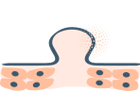Cutis Laxa Precision Panel
Cutis Laxa (CL), also known as elastolysis, is an inherited or acquired group of connective tissue disorders characterized by inelastic skin that hangs loosely in folds. Since the connective tissue is the tissue that helps body growth as well as serving as a scaffold for cells and organs, the clinical presentation and mode of inheritance is heterogeneous.





